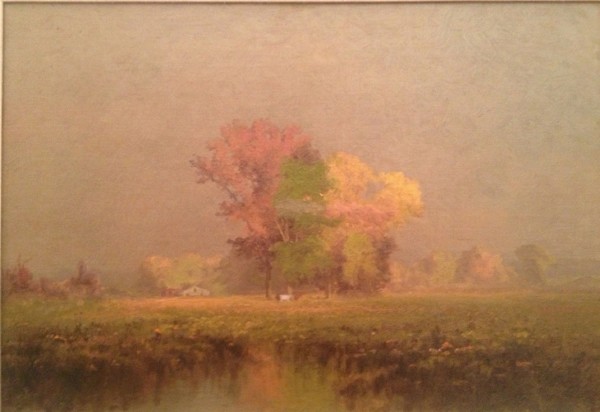-
Artist: Douglas Volk (American, 1856-1935)
Stephen Arnold “Douglas” Volk
“(Stephen) Douglas Volk, an American painter most well-known for painting landscapes with American themes (Colonial and Puritan life) and life-sized portraits, was born in Pittsfield, Massachusetts in 1856” (1).
The son of sculptor Leonard Volk, he was taken as an infant to the Midwest, where he attended primary school in Chicago. At age 14 he accompanied his parents to Rome, spending the summers of 1871 and 1872 in Venice with William L. Picknell and William G. Bunce. In Rome, he briefly attended the St. Luke's Academy. Volk moved to Paris in 1873, entering Jean-L‚on G‚r"me's atelier at the Ecole des Beaux-Arts after a short period of work under L‚on Bonnat. With the exception of a visit to the United States in 1876, he remained based in Paris until 1878, spending much of his time with friends J. Alden Weir, George de Forest Brush, and Kenyon Cox” (2).
“He was only 19 when his landscape painting “In Brittany” was shown at the Paris Salon. He was one of the youngest artists participating in that year’s exhibition” (1).
“Following his return from Europe, Volk passed three months in Chicago before assuming a teaching post at the Cooper Union in 1879. A year later, he was elected to the Society of American Artists” (2).
“In 1886 the newly formed Minneapolis Society of Fine Arts, ancestor of today's Minneapolis College of Art and Design and the Minneapolis Institute of Arts, summoned Volk to establish its art school. He remained in Minneapolis for seven years, and also painted two mural-sized historical canvases, "Father Hennepin Discovering the Falls of St. Anthony" and "The Second Minnesota Regiment at Missionary Ridge", for the Minnesota State Capitol's Governor's Reception Room around 1905” (3).
“Following World War I, he was asked to paint portraits of King Albert of Belgium, David Lloyd George, and John J. Pershing. Like his father, he was also known for his depictions of Abraham Lincoln. He served on the NAD Council from 1916 to 1919, followed by a six-year term as recording secretary. From his home in Maine, Volk kept up contact with the Academy until his death. His last letters in the Academy archives indicate that he suffered from poor health and a serious shortage of money” (2).
“Douglas Volk died in 1935 in Fryeburg, Maine” (1).
Reference:
1.
The Famous Artists Staff. Douglas Volk [internet]. 2010 [updated 2015; cited 2015 August 7]. Available from: http://www.thefamousartists.com/douglas-volk
2.
National Academy Museum Staff. Stephen Arnold Douglas Volk: 1856-1935 [internet]. [cited 2015 August 7]. Available from: http://www.thefamousartists.com/douglas-volk
3.
Askart Staff. Douglas Volk [internet]. [cited 2015 August 7]. Available from: http://www.askart.com/artist_bio/Douglas_Volk/38134/Douglas_Volk.aspx
